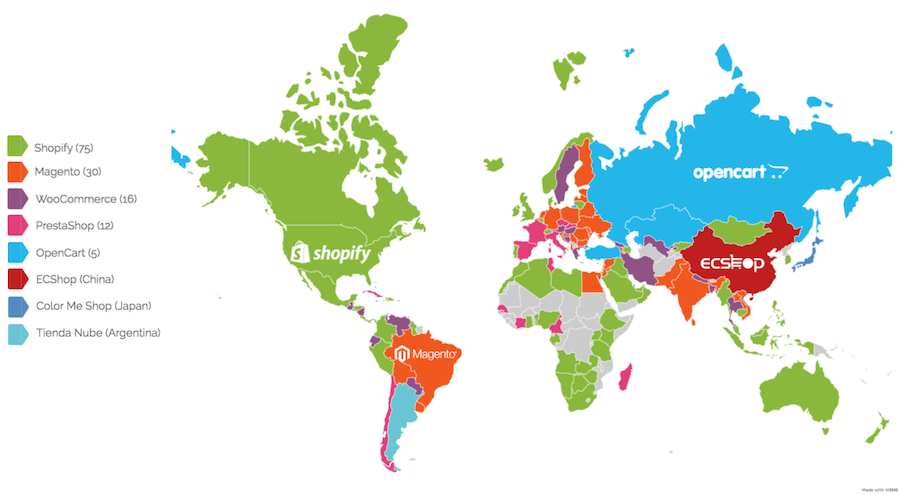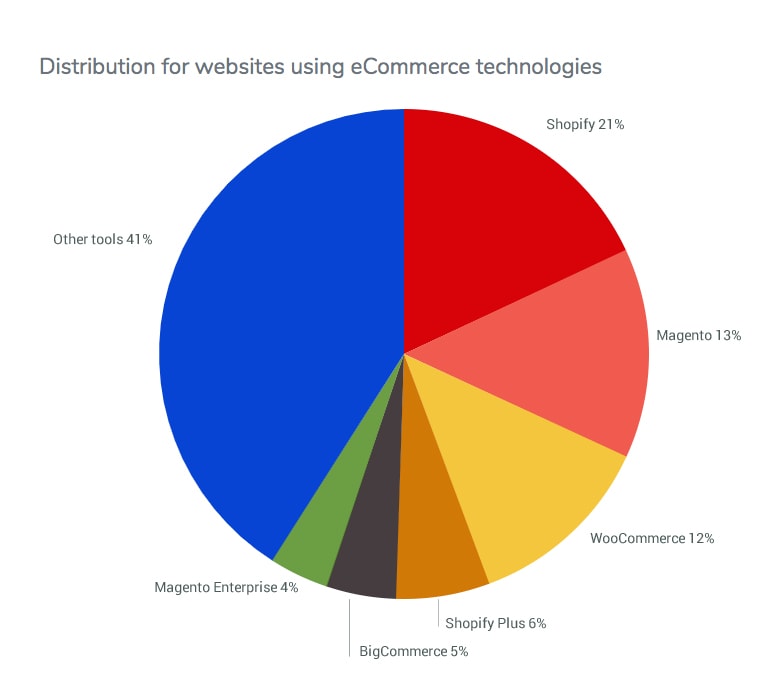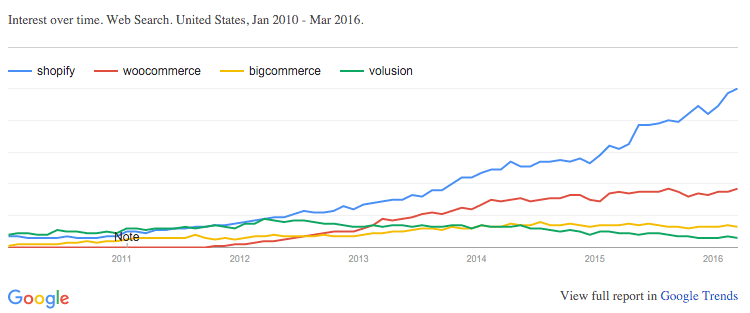How To Compare Ecommerce Platforms
The table above allows you to compare the features and prices of the most popular ecommerce platforms for building online stores. You can also compare our ratings of how well each platform performs (evaluated according to our rigorous testing methodology).
To add missing ecommerce platforms to the comparison tool, simply click on the “Add to comparison” button in the top left corner of the table and select a platform from the pop-up.
Note: the table can’t display more than five platforms at once.
If you want to learn more about a specific platform, scroll down for a video and short summary of each one. Or there are more comprehensive reviews of each ecommerce platform which can be accessed by clicking on the “Read full review” buttons at the bottom of the table.
We also have a detailed guide to help you find the best ecommerce website builder to create your own online business. And don’t miss our tutorial on how to start an online store.
Comparing Ecommerce Platforms In Detail
Shopify
The Swiss Army Knife of Online Stores
Shopify is an excellent ecommerce platform for smaller and larger online stores. You can create an unlimited number of products and there is no bandwidth limitation, which makes the online store incredibly easy to scale, depending on your needs.
Not only does Shopify include excellent ecommerce design templates (including a great range of free themes), you can also edit them according to your own preferences. Pros have complete access to the template code and they can add more features to the store through the integrated API. Alternatively, you can use the app store. This allows you to integrate many standard features without the need for coding.
If you choose Shopify, you can start selling through multiple channels: Amazon, Facebook, Pinterest, eBay, and many more. You can even add a purchase button for your online store on other websites!
Shopify also has all the relevant payment and shipping methods covered. Stores based in the USA or Canada additionally benefit from the integrated Shopify Payment and Shopify Shipping solutions. If possible, you should absolutely use these services, as otherwise Shopify will charge up to a 2% transaction fee on each sale.
If that doesn’t bother you, then Shopify is one of the most robust solutions you can choose, without needing to worry about the technology, allowing you to focus completely on sales.
For more information, you can read our comprehensive Shopify review, or see how it compares to several other ecommerce platforms:
- Shopify vs BigCommerce
- Shopify vs WooCommerce
- Shopify vs Wix
- Shopify vs Squarespace
- Shopify vs Amazon
And of course you can also find out more on the Shopify Online Store!
BigCommerce
The Name Says It All
Even though the name suggests otherwise, BigCommerce is designed for both small and big online stores. Unlike Wix or Weebly, this platform is built with ecommerce as its main focus, just like Shopify. With BigCommerce you’ll be able to sell unlimited products with any plan. This includes B2C and B2B.
As opposed to some of their competitors, BigCommerce doesn’t charge any additional transaction fees nor limits your online traffic. But each plan has a yearly sales threshold limit. If you go over it, you’ll be moved to a superior (and more expensive) plan, even if you don’t need the extra features.
After testing BigCommerce, we were impressed with their SEO features. They have all the most important SEO options store owners might require, and they are easy to implement. For example, customizing title tags, meta-descriptions and URLs is a walk in the park. More advanced features like 301 redirects and sitemaps are also included. Learn more about BigCommerce SEO.
Unless you are ready to dig under the BigCommerce hood, there isn’t a way to create multilingual online stores. It’s true that multilingual support for online stores is something that all store builders need to improve, but some of their competitors have solutions that don’t require coding experience.
BigCommerce is great to create online store related content. In other words, adding products and categories is straightforward. However, if you need to add other types of content (e.g. blog post or landing pages), things go south quickly as it’s not optimized for these.
Read more in our BigCommerce review, our BigCommerce vs Shopify comparison, or on the BigCommerce website.
WooCommerce
Best Ecommerce add-on for WordPress
WooCommerce is the number one ecommerce plugin for WordPress. You can use it for smaller and bigger online stores. However, it’s not exactly beginner-friendly because getting it all set up isn’t nearly as self-explanatory as the other ecommerce platforms.
The first issue is that you will have to check whether your theme (meaning, your general website layout) is even compatible with WooCommerce in the first place. Making adjustments completely depends on the theme’s settings. Should the theme lack proper documentation, you won’t be able to make any progress unless you consult with a professional WordPress developer.
And even if WooCommerce is in itself free of charge, don’t forget the hidden costs of a domain, hosting, the theme, additional plugins, or extensions.
WooCommerce can shine, however, if you want to sell internationally. By combining it with a plugin such as WPML, your shop can be multilingual. Since we’re talking about open source software, you can also make adjustments and changes at any time (however, remember that this will cost you some time and effort).
On the other hand, that also means that there is no dedicated support unless you’re working with an agency or freelancer who offers additional help.
If you aren’t exactly tech-savvy and don’t already have a WordPress website, we recommend checking out an ecommerce platform such as Shopify. It’s just easier to use.
More information about the WooCommerce Online Store
Wix Ecommerce
Great Value
Wix Ecommerce is an excellent choice if you want to create a great-looking online store, all thanks to their 100+ ecommerce templates. Use their fantastic image and video function to give your product galleries that extra pizazz, and always rest assured that everything will look great on phones and tablets. They’re bound to have something for your taste, too.
This ecommerce platform is ideal for smaller online stores, due to its ease of use and reasonable price. All the products are centrally managed, which is similar to Weebly’s solution. You can sell both physical goods and digital downloads.
Available payment methods cover all the classics: money transfers, credit cards, PayPal. Wix doesn’t even charge a transaction fee.
Wix offers multiple ecommerce plans, but its key features are available even in the lower pricing tiers. You can also try out all the settings in the free version, but you won’t be able to accept payments without paying.
One interesting addition to the online store is Wix Ascend. You can use it to send newsletters to your customers, keeping them up to date on news, offers, and other highlights.
More information about the Wix Online Store
Squarespace Commerce
For Creatives With eCommerce Ambitions
If you’re already a fan of Squarespace’s sleek templates and minimalist aesthetic, you’ll love what they offer in the way of ecommerce. Their online store templates are perfectly geared towards anyone looking to imbue a sense of high design and craftsmanship into their products – you can imagine handcrafted homewares, trendy footwear and exclusive jewellery all slotting in seamlessly to their website designs.
But Squarespace Commerce is actually much more versatile than that. It also allows you to sell digital products, subscriptions, and services. So whether you’re selling monogrammed handbags, digital artwork, candle-making classes or monthly coffee subscriptions, Squarespace has you covered. And all that without any sales fees from Squarespace.
Not only that – Squarespace’s recently-revamped product editor gives you a generous amount of control over your product pages, with options to customize product descriptions with forms, videos, related products, Instagram feeds and more.
While you can be sure that your storefront will look flawless, there are just a few small things in the backend we’d like to see improved. Automatic tax rates, for the moment, are only available in the US (via a TaxJar extension). Same goes for real-time shipping rates – these apply to domestic deliveries within the US only.
Payment processors are limited to Stripe and PayPal (with additional options for AfterPay and Square for POS payments). And there is still no way to accept offline payments (e.g. cash or check).
Despite this, we still think Squarespace is an interesting option for anyone looking to open a small online store – especially if design is a key consideration.
More information about the Squarespace Online Store
Weebly Ecommerce
Makes Selling Super Easy
Weebly is one of the ecommerce platforms geared towards smaller stores. The simple structure makes the setup process particularly smooth, and product management is also easy thanks to Weebly’s centralized system. Should your shop see significant growth, you can import and export products. By using external software such as Excel, updating your prices, for example, can be much faster.
Obviously, you can sell more than just standard products such as t-shirts or jewelry. You can also sell digital goods like MP3s or ebooks. Thanks to the Weebly App Center, adding customer reviews to the store is a piece of cake as well.
If you sell to customers in different regions, you can enter tax information for each country individually. In case some of your customers are located in the United States, you can even automate the tax settings completely.
This applies to shipping information too. Thanks to real time shipping rates, your customers will always see the actual cost of shipping when going to checkout.
Of course, support is also included in the package. Apart from the standard FAQ, you can use email, a live chat, or you can call the Weebly support team from your phone.
More information about the Weebly Online Store
Ecwid
The Plug-in That’s Packed With Features
Ecwid is an ecommerce platform that plugs into your existing website, letting you sell products without having to rebuild your site. It’s easy to use, packed with features, and is one of the few ecommerce solutions to offer a completely free plan (as long as you’re selling fewer than 10 products).
Upgrading to one of its affordable paid plans unlocks extra features such as additional sales channels, inventory tracking, product variations and filters, and abandoned cart emails.
Depending on where you’re located, you can also get integrate with more than 50+ payment systems, real-time shipping rates, and automatic tax calculations. Ecwid also boasts excellent multilingual features that won’t cost you any extra to use.
So what’s the catch? Customizing the design of your product pages isn’t as straightforward as it could be, as you’ll need either a third-party app or CSS knowledge. Ecwid’s Instant Site feature, which lets you set up a standalone site for your store, is also pretty basic (for the moment, at least).
Finally, while Ecwid have improved their SEO in recent years thanks to the introduction of SEO-friendly URLs, the fact that they’re autogenerated may cause duplication issues – just something to be wary of.
Volusion
A Solution for Experts
Volusion is one of the most popular ecommerce platforms. They claim to be ‘the all-in-one ecommerce solution’ in the market. It’s a similar concept to Shopify and BigCommerce.
Its entry level prices are a bit cheaper than the competition. However, they limit the amount of traffic your website can receive (e.g. 1 GB, 3GB, 10 GB or 35 GB) and they also limit the number of products that you’ll be able to sell with each plan. So in the end they may not be cheaper for you.
Their ecommerce features are comparable to their competitors and they offer similar tools for you to work on your store’s marketing (e.g. coupons, Amazon integration, etc).
However, the difference is that Volusion’s system is not as easy to use as the other tools. For example, creating regular content (e.g. a promotional page) is somewhat complicated, and most likely you’ll need to read an entire support article before you do.
It also has some key features missing that you should be aware of before purchasing this ecommerce platform. For example, if you need a blog, you’ll have to connect one created with an external tool (e.g. WordPress).
Ecommerce Platforms: Comparative Search Interest
Google provides a very interesting trend graph of the three biggest hosted ecommerce platforms, plus WooCommerce (the most popular WordPress plugin).
Shopify’s dominance over their direct competitors is almost unreal, as measured by Google search volume. Interest in Shopify is more than twice as high than in WooCommerce (see our direct comparison of Shopify vs WooCommerce). Trailing far behind there is BigCommerce, which has a search volume twice as high as Volusion.
We didn’t include the non-purebread ecommerce solutions, such as Weebly and Wix, as their graph would be diluted by searches for their regular website builders.
Shopify’s dominance is also reflected in GoogleTrends, where it has managed to bag the number 1 popularity spot among online creation platforms. And if we look at their actual usage figures for countries like USA, United Kingdom, Australia or Canada, Shopify seems to be getting a 30% market share, which isn’t bad for a company that started in 2006. Other reports from Statista seem to indicate similar trends.

Ecommerce platform popularity (Source: Google Trends & BuiltWith)
But, if we take BuiltWith’s global estimates, we can see that WooCommerce is still the most popular ecommerce platform, with 26% of the market share, followed by Shopify with 19%; Magento seems to power 9% of the online stores. BigCommerce and OpenCart are less than 5%.

Ecommerce platforms market share: top 100,000 online stores (Source: BuiltWith)
However, when we only look at the top 100,000 online stores in terms of traffic, we see that Shopify is again the king, with 21% of the market share. On top of that, Shopify Plus (their enterprise solution) adds an extra 6%.
Anyways, these aren’t definitive numbers, but they should give us an idea of what ecommerce platforms are the most relevant out there. If you are interested in finding out what the most popular solutions per country are, check this 2019 study out.
Which Is The Best Ecommerce Platform?
While our ecommerce platform comparison tool can give you give you a great overview of the different features and prices offered by the various vendors, the best option for your online store will depend on a whole load of very personal considerations.
The right platform for one person will be completely wrong for someone else. That’s why we put together a comprehensive guide to finding the best ecommerce platform for your online business!
THE BEHIND THE SCENES OF THIS REVIEW
This article has been written and researched following a precise methodology.
Our methodology












